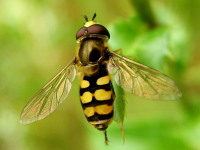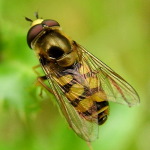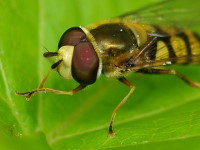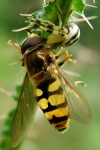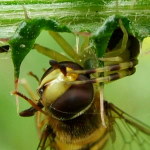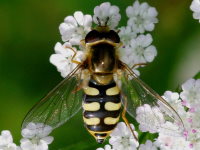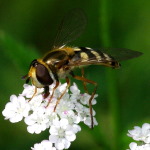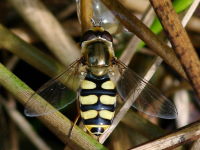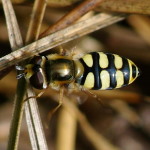Phylum Arthropoda (Arthropods) ➔ Subphylum Hexapoda (Hexapods) ➔ Class Insecta (Insects) ➔ Order Diptera (True flies) ➔ Family Syrphidae (Hoverflies)
Eupeodes corollae (Fabricius, 1794)
Gemeine Feldschwebfliege Migrant Hoverfly
Synonyms and other combinations:
Metasyrphus candidus Matsumura, 1918 | Metasyrphus libyensis Nayar, 1978 | Musca pyrorum Schrank, 1803 | Musca vorax Geoffroy, 1785 | Scaeva annularis Curtis, 1837 | Scaeva octomaculata Curtis, 1837 | Scaeva olitoria Fallen, 1817 | Syrphus algirus Macquart, 1849 | Syrphus berber Bigot, 1884 | Syrphus cognatus Loew, 1858 | Syrphus corolloides Macquart, 1850 | Syrphus crenatus Macquart, 1829 | Syrphus dentatus Walker, 1852 | Syrphus disjunctus Macquart, 1842 | Syrphus flaviventris Macquart, 1829 | Syrphus fulvifrons Macquart, 1829 | Syrphus lacerus Meigen, 1822 | Syrphus nigrifemoratus Macquart, 1829 | Syrphus terminalis Wiedemann, 1830 |
Classification:
Eupeodes corollae belongs to the subfamily Syrphinae, tribe Syrphini.Distribution:
From Iceland, Fennoscandia and the Faroes south to Iberia, the Mediterranean, Madeira, the Canary Isles and North Africa; coastal States of Africa down to and including South Africa; Mauritius; from Ireland eastwards through most of Europe into European parts of Russia; through Siberia from the Urals to the Pacific coast; Japan; China; Formosa.Habitat:
Preferably in open ground: grasland, farmland, gardens, parks.Description:
Eupeodes corollae has a body length of 7 - 10.5 mm. The thorax is monochrome brown, the scutellum almost yellow haary. On the abdomen are 3 pairs of yellow spots. The curved pairs of spots on the segments 3 and 4 always go beyond the lateral seam and have in the males usually a narrow connection in the middle. The eyes are hairless, the antennae are brown. In females, the frons is black above and yellowish below.Biology:
Eupeodes corollae flies in several generations from April to October (all year round in southern Europe). The species is one of the seasonal migrants. These usually fly southwards in large numbers before winter and can travel considerable distances. Their offspring will move north again in spring.The Imagines visit the flowers of umbelliferae, Cirsium, Galeopsis, Hypericum, Ranunculus, Tussilago and other plants from different families. The male Eupeodes corollae from 2007 shown here was probably somewhat inattentive during the flower visit and became the victim of a subadult male of the Goldenrod Crab Spider Misumena vatia. When a male has found a female, the mating begins in flight and continues in the vegetation or on the ground. A female lays hundreds of eggs in aphid colonies on different plants.
The larvae feed on aphids. Larval development is temperature dependent and lasts about 7 to 25 days. During this time a larva eats several hundred aphids. The subsequent pupal stage lasts about 8 days. Eupeodes corollae can overwinter as a puparium. At temperatures below 4 °C, the development of the puparium stagnates. Only at higher temperatures, the puparium continues to develop until a new fly hatches.
Annotation:
The species is found in the older literature under the name Metasyrphus corollae.References, further reading, links:
- Pape T. & Thompson F.C. (eds) (2017). Systema Dipterorum (version 2.0, Jan 2011). In: Species 2000 & ITIS Catalogue of Life, 2017 Annual Checklist (Roskov Y., Abucay L., Orrell T., Nicolson D., Bailly N., Kirk P.M., Bourgoin T., DeWalt R.E., Decock W., De Wever A., Nieukerken E. van, Zarucchi J., Penev L., eds.). Digital resource at www.catalogueoflife.org/annual-checklist/2017. Species 2000: Naturalis, Leiden, the Netherlands. ISSN 2405-884X.
- Gerald Bothe: Bestimmungsschlüssel für die Schwebfliegen (Diptera, Syrphidae) Deutschlands und der Niederlande, DJN, 1984, ISBN 3-923376-07-3
- M.C.D.Speight: Species Accounts of European Syrphidae (Diptera), Glasgow 2011, Syrph the Net, the database of European Syrphidae, vol. 65, 285 pp., Syrph the Net publications, Dublin.
- Menno Reemer, Willem Renema, Wouter van Steenis, Theo Zeegers, Aat Barendregt, John T. Smit, Mark P. van Veen, Jeroen van Steenis, Laurens van der Leij: De Nederlandse Zweefvliegen (Diptera: Syrphidae), Nederlandse Fauna 8, 2009.
- Anasimyia interpuncta
- Anasimyia transfuga
- Baccha elongata
- Blera fallax
- Brachyopa sp.
- Brachypalpoides lentus
- Brachypalpus laphriformis
- Brachypalpus sp.
- Brachypalpus valgus
- Ceriana conopsoides
- Ceriana vespiformis
- Chalcosyrphus femoratus
- Chalcosyrphus nemorum
- Chalcosyrphus valgus
- Cheilosia albipila
- Cheilosia albitarsis
- Cheilosia chrysocoma
- Cheilosia illustrata
- Cheilosia pagana
- Cheilosia scutellata
- Cheilosia sp.
- Cheilosia variabilis
- Chrysogaster sp.
- Chrysotoxum bicinctum
- Chrysotoxum fasciatum
- Chrysotoxum festivum
- Chrysotoxum verralli
- Criorhina berberina
- Dasysyrphus albostriatus
- Dasysyrphus sp.
- Dasysyrphus tricinctus
- Didea fasciata
- Didea intermedia
- Didea sp.
- Epistrophe diaphana
- Epistrophe eligans
- Epistrophe flava
- Epistrophe grossulariae
- Epistrophe melanostoma
- Epistrophe melanostoma/nitidicollis
- Epistrophella euchroma
- Episyrphus balteatus
- Eristalinus aeneus
- Eristalinus megacephalus
- Eristalinus taeniops
- Eristalis arbustorum
- Eristalis interrupta
- Eristalis intricaria
- Eristalis lineata
- Eristalis pertinax
- Eristalis rupium
- Eristalis similis
- Eristalis sp.
- Eristalis tenax
- Eumerus purpurariae
- Eumerus sp.
- Eupeodes corollae
- Eupeodes luniger
- Eupeodes sp.
- Eurimyia lineata
- Ferdinandea cuprea
- Hammerschmidtia ferruginea
- Helophilus hybridus
- Helophilus pendulus
- Helophilus sp.
- Helophilus trivittatus
- Ischiodon aegyptius
- Leucozona glaucia
- Leucozona laternaria
- Leucozona lucorum
- Melangyna lasiophthalma
- Melangyna quadrimaculata
- Melangyna umbellatarum
- Melanogaster sp.
- Melanostoma scalare
- Meligramma triangulifera
- Meliscaeva cinctella
- Merodon ambiguus
- Merodon avidus
- Merodon equestris
- Merodon moenium
- Merodon obscuritarsis
- Merodon sp.
- Microdon analis/major
- Microdon mutabilis/myrmicae
- Myathropa florea
- Myolepta dubia
- Orthonevra sp.
- Paragus sp.
- Parasyrphus lineolus
- Parhelophilus sp.
- Pipiza austriaca
- Pipiza bimaculata
- Pipiza fenestrata
- Pipiza quadrimaculata
- Pipiza sp.
- Platycheirus rosarum
- Platycheirus sp.
- Rhingia campestris
- Rhingia rostrata
- Scaeva albomaculata
- Scaeva pyrastri
- Scaeva selenitica
- Sericomyia lappona
- Sericomyia silentis
- Sphaerophoria rueppelli
- Sphaerophoria scripta
- Sphaerophoria sp.
- Sphegina sp.
- Spilomyia saltuum
- Syritta pipiens
- Syrphus ribesii
- Syrphus sp.
- Syrphus vitripennis
- Temnostoma bombylans
- Temnostoma meridionale
- Temnostoma vespiforme
- Tropidia scita
- Volucella bombylans
- Volucella inanis
- Volucella inflata
- Volucella pellucens
- Volucella zonaria
- Xanthogramma citrofasciatum
- Xanthogramma pedissequum
- Xylota segnis
- Xylota sp.
- Xylota sylvarum
